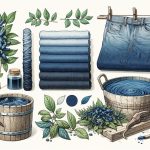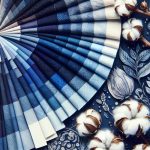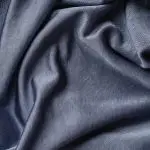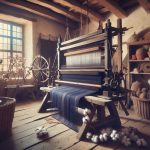Ever wondered why denim has its own cult following in fashion? It's not just another fabric; its unique twill weave and the iconic indigo blue set it apart. I've always been fascinated by how something so simple became a staple in wardrobes around the globe. The blend of durability and style that denim offers is unmatched, but there's so much more to its story, from its humble beginnings to becoming the go-to material for comfort and rugged elegance. Stick around, and let's unravel the layers behind denim's enduring appeal.
Table of Contents
Key Takeaways
- Denim features a distinctive twill weave, creating its characteristic diagonal ribbing for enhanced durability.
- It's primarily made from cotton, providing both comfort and breathability, unique to its fabric type.
- Denim utilizes indigo dye, allowing for unique wear patterns and color vibrancy over time.
- Incorporates a blend with synthetic fibers for varieties like stretch denim, combining traditional texture with modern flexibility.
- Evolved through global cultures, denim merges craftsmanship, innovation, and eco-friendly practices for a versatile and sustainable fabric choice.
The Unique Weave of Denim
The unique weave of denim, with its diagonal lines and durable texture, sets it apart in the world of textiles. You see, it's all about the twill weave. This technique is where the magic happens, using patterns of three warp yarns over one weft yarn. It's not just any kind of weave; it's what gives denim its distinctive look and feel. Those diagonal ribbings you see? They're not just for show. They're the backbone of denim's durability, offering strength and resilience like no other.
What's truly fascinating is how this twill weave contributes to both a unique texture and comfortable wear. It's this combination that makes denim such a standout in the fashion industry. It's versatile, it's enduring, and let's be real, it's pretty much everyone's go-to for a reason. The weave allows for ease of movement, making it a top choice for everything from jeans to jackets. So, when you're slipping into your favorite pair of denim, you're not just wearing a piece of clothing. You're wearing a masterpiece of textile engineering, designed for both comfort and style.
The History of Denim
So, let's talk about where denim comes from and how it's changed over time.
It all started in the 1600s in France, and since then, it's been on quite the journey, mixing European and American influences.
I'm excited to explore its origins and evolution, seeing how this fabric became the icon it's today.
Origins of Denim
Digging into the origins of denim reveals its start in 1600s France, known back then as serge de Nîmes. It's fascinating to see how this twill weave fabric, initially crafted from cotton, marked the beginning of a journey that intertwined European and American traditions.
Here's why understanding its roots matters:
- Serge de Nîmes: Not just a fabric, but a testament to denim's enduring legacy.
- Bleu de Gênes: Highlights the global tapestry of denim, tracing back to Genoa, Italy.
- Twill weave: The backbone of denim's durability and unique appearance.
This blend of tradition and innovation from both sides of the Atlantic set the stage for denim's unwavering presence in our wardrobes. It's more than fabric; it's a cultural artifact.
Evolution Through Time
As we delve into denim's history, it's clear that its journey from a French twill to a global staple is both fascinating and complex. Originating in the 1600s as serge de Nîmes, this twill weave quickly made its mark. The term 'denim' itself morphed from this fabric's name, highlighting its roots.
Meanwhile, over in Genoa, Italy, a similar fabric, Bleu de Gênes, was making waves among manual workers for its durability. What's intriguing is how these European textile traditions merged with American innovation. By the early 1700s, textile mills in the U.S. adapted the twill weave technique, utilizing local cotton.
This blend of tradition and innovation set the stage for denim to become the beloved fabric we know today.
Why Denim Is Blue
Let's dive into why denim is blue; it's all because of the indigo dye that's been used for ages. This deep blue dye isn't just any colorant; it's what gives denim its soul. Traditionally, indigo dye was chosen for its vibrant color and durability, traits that make denim the go-to fabric for both work and fashion.
Here's what makes the blue of denim so special:
- Indigo's Resistance to Fading: Unlike other dyes, indigo doesn't penetrate the fabric fully. Instead, it coats the surface, which leads to the iconic worn-in look over time as the dye gradually wears off with each wash and wear.
- Deep Blue Hue: The intensity of the color can be adjusted by dipping the fabric multiple times in the dye, allowing for a range of blues, from light to a rich, deep blue.
- Heritage and Authenticity: The blue color has become synonymous with denim itself, representing its long history and the authenticity that comes with wear.
The Making of Denim
To understand denim's unique charm, it's crucial to delve into its creation process, which starts with the distinctive twill weaving of primarily cotton fibers. This method isn't just about tangling threads together; it's a meticulous craft that gives denim its signature look and feel. The diagonal ribbing you see? That's all thanks to the weaving pattern, a small detail that makes a big difference in durability and style.
Let's break it down a bit:
| Aspect | Description |
|---|---|
| Weaving Process | Twill technique creating diagonal ribbing for texture and durability. |
| Material | Primarily cotton fibers, sometimes blended with synthetic fibers for extra strength. |
| Dyeing Process | Indigo dye is used to give denim its iconic blue color. |
Beyond the weaving and the dyeing, there's a finishing touch—a layer that ups the fabric's game against wear and tear. It's this combination of the weaving process, the cotton fibers (or their blend with synthetics), and that deep indigo dye that really sets denim apart. Creating a fabric that's not just tough but also has that classic look we all love.
Ingredients of Denim
Diving into denim's core, it's mainly crafted from 100% cotton, which ensures it's both breathable and comfy. But there's more to this iconic fabric than just cotton. Let's break it down, shall we?
- Cotton: The backbone of denim, providing that unmistakable comfort and breathability we all crave. It's what makes denim denim, offering a canvas that ages uniquely to each wearer through indigo dyeing.
- Indigo Dyeing: This ancient technique doesn't just slap color on the surface; it bonds with the cotton, fading over time to reveal those personal wear patterns we love, giving denim its character.
- Twill Weave: Not your average weave, the twill pattern gives denim its distinctive diagonal lines, adding not just to its aesthetics but also its durability. This is why your denim can take a beating and still look amazing.
Modern twists include blending in synthetic fibers like polyester to introduce stretch while boosting durability. This mix ensures that denim not only fits better but also lasts longer, adapting to our active lifestyles. So, whether it's pure cotton or a smart blend, the essence of denim lies in its unique combination of tradition and innovation.
Denim's Evolution
After exploring what denim is made of, I'm now turning our attention to how it's changed over the years. Denim's journey from tough workwear to a fashion essential is nothing short of remarkable. Initially, it was all about durability, but then came a game-changer: stretch denim. With a bit of elastane thrown into the mix, denim became not just durable but also super comfy and flexible. It was a revelation!
The 1980s saw another twist with acid-washed denim. This wasn't just any old pair of jeans; it was a statement, thanks to a chemical process that gave it a distinctive, vintage vibe. Fast forward to today, and the evolution of denim hasn't slowed down. Techniques like synthetic indigo dyeing and laser fading are all about giving denim that modern edge while keeping up with the trends.
But it's not just about looks. Sustainability practices are reshaping how denim is produced. The industry's moving towards eco-friendly methods, proving that you can be stylish and conscious about the planet. So, there you have it, denim's evolution in a nutshell—always adapting, always innovating.
Types of Denim Explained
Let's break down the different types of denim and what makes each one unique. At its core, denim is a sturdy twill fabric that's become a global fashion staple, but not all denim is created equal. Whether you're a denim aficionado or just looking to up your jeans game, understanding these variations can really elevate your wardrobe.
- Raw Denim: This type hasn't been washed or treated after dyeing, which means it's pretty stiff at first. But the cool part? It'll mold to your body over time, creating a custom fit and unique wear patterns that are totally yours.
- Selvedge Denim: Known for its quality, selvedge denim is made on old-style shuttle looms. It has a clean edge that doesn't fray, signifying durability and a nod to denim's heritage. It's the choice for purists who appreciate the craftsmanship behind their jeans.
- Stretch Denim: By mixing in a bit of elastane or spandex with the cotton, stretch denim offers a forgiving, flexible fit. It's the go-to for everyday comfort without sacrificing style.
Then there's acid-washed denim, which brings a whole different vibe with its faded, edgy appearance. Each type of denim brings something unique to the table, whether it's in the feel, the look, or the longevity of your jeans.
The Indigo Dye Process
So, let's talk about how denim gets its cool colors.
Starting from the origins of indigo dye, we'll explore how traditional techniques have shaped the way our jeans look and feel.
Then, we'll see how modern innovations are mixing things up in the world of denim dyeing.
Origins of Indigo Dye
The indigo dye process, a tradition stretching back thousands of years, finds its roots in India and ancient civilizations like Egypt and Mesopotamia. It's amazing how this technique has survived the test of time, especially considering it all starts with the humble Indigofera tinctoria plant. This plant's magic transforms through fermentation into a vibrant blue pigment that's then ready for the vat dyeing process.
- Unchanged essence: Despite modern advancements, the core principle of creating a surface color while keeping the fabric's interior untouched remains a testament to the dye's unique properties.
- Cultural tapestry: The indigo dye process is woven into the fabric of many cultures, highlighting its global significance.
- Denim's soul: This blue pigment is the heart of denim, giving it that iconic look we all love and crave.
Traditional Dyeing Techniques
Diving into traditional dyeing techniques, I find the indigo dye process fascinating for turning basic cotton into the deeply colored denim we all wear. This old-school method involves dunking the yarns repeatedly to get that perfect blue shade.
What's cool is that indigo dye just coats the surface of the fibers, which sets the stage for denim to evolve uniquely over time. As you wear and wash your jeans, they start to fade in a way that's all your own, thanks to the indigo gradually wearing off.
This creates those personalized fade patterns and a patina that truly mirrors your lifestyle. It's this traditional indigo dyeing process that gifts our denim with its character, making each piece a reflection of our own stories.
Modern Innovations in Dyeing
While we've long cherished the traditional indigo dye process for its unique characteristics, it's fascinating to see how modern innovations are reshaping the way we dye denim today. The use of synthetic dyes in indigo dyeing now allows us to achieve consistent color saturation that was hard to nail down before.
But what's really game-changing are:
- Foam dyeing techniques that drastically cut down on water use and chemical waste.
- Laser fading technology for creating those cool, distressed looks without the environmental toll of sandblasting.
- Sustainable practices that include using eco-friendly methods and recycling water, making the whole process kinder to our planet.
These advancements not only offer precise color control but also open the door to customization in denim production, pushing us towards a more sustainable future.
Denim in Global Cultures
Exploring how denim weaves through global cultures reveals its versatile identity, from artisanal craft to high-fashion staple. It's fascinating how this cotton fiber, popularized by Levi Strauss, has evolved.
In Japan, denim isn't just clothing; it's an art form. Japanese craftsmanship in denim is unmatched, focusing on the quality and detail that turns a simple pair of jeans into a masterpiece.
Over in the States, denim screams American culture. It's the fabric of the free, embodying rugged individualism and the spirit of adventure.
Crossing the pond, Europe's fashion circles have hoisted denim to dizzying high-fashion status. European designers skillfully incorporate denim into their luxury collections, showcasing its versatility beyond casual wear.
Meanwhile, in India, denim gets a local twist, blending seamlessly with traditional attire to make bold fashion statements. It's a fusion that captures the imagination, merging modernity with cultural heritage.
Down in Africa, communities are turning denim into a storytelling canvas. They're not just wearing jeans; they're adorning themselves in narratives, using unique patterns and designs to share their stories. Denim, it seems, is the global language of self-expression, cutting across cultures with its rich, textured tales.
Caring for Denim
Caring for your denim the right way can make a huge difference in how it ages and looks over time. Given that most denim is made from cotton, a natural fiber, it requires a bit of know-how to keep it looking its best, especially if it's dyed with indigo, which is prone to fading and color bleeding. I've found that a few simple steps can ensure your denim stays in top condition without much fuss.
- Wash infrequently: I've learned that less is more when it comes to washing denim. Washing it too often can strip away the indigo dye and weaken the cotton fibers, leading to faded colors and a shorter lifespan for your jeans.
- Cold water and medium cycle: I always stick to cold water and a medium cycle for washing my denim. This prevents it from shrinking and helps maintain the vibrant color without causing undue stress on the fabric.
- Hang drying: I've ditched the dryer for my denim. Hang drying not only prevents excessive wear and tear but also ensures that my jeans don't shrink or lose their shape. It's a simple step that significantly extends the life of my denim.
Frequently Asked Questions
What Makes Denim Different?
I've noticed denim's unique because of its durable cotton twill fabric and the special indigo dyeing process. This combo allows for cool aging patterns and makes it different from other materials I've worn.
What Is Difference Between Denim and Jeans?
I've learned that the main difference between denim and jeans is pretty straightforward: denim's the tough fabric they're made from, and jeans are the actual pants. Denim's versatility goes beyond just making jeans, though.
What Is the Difference Between Denim and Non Denim Fabric?
I've learned that denim differs from non-denim by being a cotton twill with diagonal ribbing. Non-denim lacks this and varies more in materials like polyester. Denim's unique for its indigo dye and durability, too.
What Are the Characteristics of Denim Jeans?
I've learned that denim jeans stand out due to their 100% cotton twill weave, unique indigo dye fades, varying weights, and finishes like raw or washed denim. They're super versatile, fitting various styles and trends.
- How Does Ring Spun Cotton Affect Garment Fit and Shape Retention? - August 13, 2024
- What Are the Challenges in Producing Ring Spun Cotton? - August 13, 2024
- Is Ring Spun Cotton Suitable for Plus-Size Clothing? - August 13, 2024







